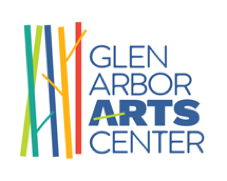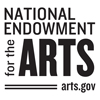
Creativity Q+A with Nick Preneta
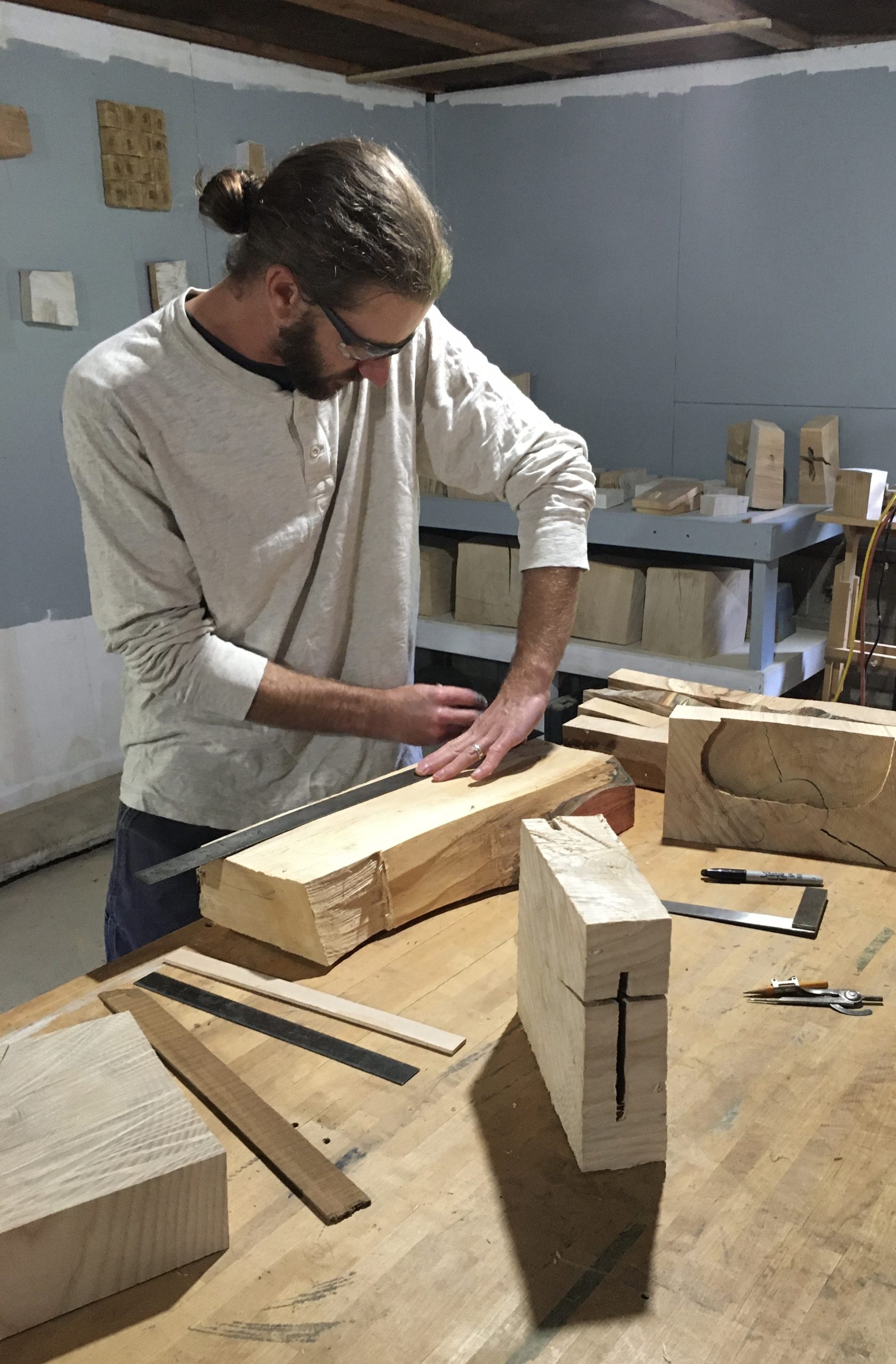
Nick Preneta, 37, works in wood. Green wood. Mostly with his chain saw. Notching and carving and creating marks, both intentional and serendipitous. The Leelanau County artist, trained as a furniture builder, began to explore the aesthetics of non-functional wood shapes and objects when he started looking at the scraps he was generating. This interview took place in September 2021. It was conducted by Sarah Bearup-Neal, GAAC Gallery Manager, and edited for clarity.
Describe the medium in which you work.
I work in wood. Generally when I start working with wood, it’s green wood, so there’s a lot of moisture in it, and that’s a key part of my process: starting with green wood.
Why is that key?
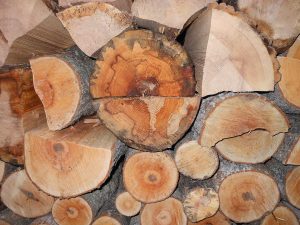
I explore the medium itself, and structural elements. Working with green wood allows me to dive deep into the structure of the wood, and explore how it changes as it loses moisture during the drying process … Different species of wood act differently during the drying process, and even the conditions the wood is under affects it. That’s what I explore. I make “suggestions” to the wood while I’m working it, by making cuts in the wood, and seeing how what I do to the wood will affect the visual outcome as it dries. I don’t know what’s going to happen — as far as the wood changing after I cut it. I look at the grain, and I have a guess, but sometimes I’m surprised. Those could be good surprises or bad surprises.
I’m really interested that you factor in things that are out of your control.
That’s really what draws me to the work I do: being able to experience something that’s out of my control. It’s a living material. Even after its cut down it can still be “living.”
What draws you to the medium in which you work?
Wood is something I’ve always been drawn to, since childhood. It goes back to playing in the woods, and making forts with sticks, making crude play toys with sticks. How I work with it has evolved over the years.
Did you attend art school or receive any formal training in visual art?
I studied at Northern Michigan University [2002-2006]. I received a BFA — it was a concentration in furniture design. I had been accustomed to woodworking before; but [school] opened up concepts of visual presentation, conceptual ideas and social implications.
What do you mean by “social implications”?
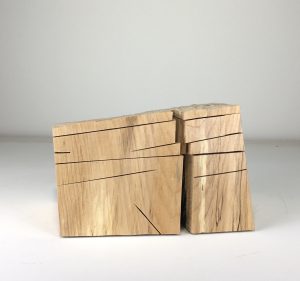
My initial goal in going to school for furniture design was to learn how to make furniture, and make useful things for peoples’ homes. But when I was there I was exposed to a lot of different studio furniture makers. So I found myself being drawn to creating forms that weren’t practical at all for making furniture; but I really liked the form. And the fact that I could make this form out of wood. That was a big mind shift for me: You can still make a piece of furniture, but it might not be functional as a piece of furniture. It could be a dining room table, but it could be saying more than this is just a surface for you to eat off of. I’m thinking of a dining room table, classically constructed and [the artist] hand-drove a nail right in the top of it [so the nail is sticking up and out of the surface] … It creates an emotional response in the viewer. At that point in my life that was really intriguing to me. I’d never explored forms like that. It was a mind-opening experience for me.
How did your formal training affect your development as a creative practitioner?
It was what I needed at the time. It exposed me to new ideas. As far as the work I do now, that was the first introduction I had to working with green wood. I developed techniques at college that I use if I get stuck with visual problems … The whole university scene of being around other people making things, having constant feedback: I realized that that’s very important.
You’re living in a place where there are a lot of creative people, but you’re not bumping into them every day like you’d would in college.
You’re not in the same studio they are. I think it’s really important, but I don’t really share a lot of my work in process with other artists. It’s something I need to do more of; but it’s something I haven’t incorporated into my work.
Describe your studio/work space.
I live on an old farm. I converted an old outbuilding for my studio. It’s approximately 16 ft x 30 ft. When I first converted it, I was still in the mindset of making furniture. So, it’s a practical work space. This suits my needs for now. I suppose, if it were a different situation, my work would be a little bit different. For instance: I work with green logs, but the space isn’t conducive to bringing big logs [into the studio], so I also work outside. I do a lot of the rough shaping outside with the chainsaw. Once the pieces of wood are broken down, I bring them inside and work in the studio. Bringing big, heavy, bulky pieces of work into my studio is cumbersome, so the scale of my work is smaller than that.
What woods are you using?
Whatever comes my way that I’m interested in. What I’m using right now is beech — there’s a lot of Beech that’s available because of the fungus. People are taking it down. I use ash — [available] because of the emerald ash borer. On my own property, I have a lot of Black Locust trees. That wood is very intriguing to me. I haven’t done a lot of it in my art work, but I have a great resource when I’m ready to do that.
What is it about Black Locust that intrigues you?
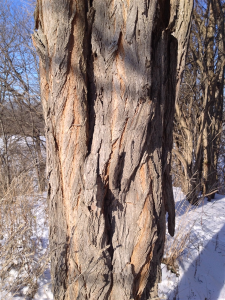
Black locust is an invasive, which is intriguing to me on its own, because it’s seen as undesirable. It’s also very useful. Farmers used Black Locust traditionally, and people are stylizing Black Locust now. It’s tough wood, very dense, and the grain structure is very interesting to me.
How does your studio/work space facilitate or affect your work?
Part of it is the space. I’m not able to drive a piece of machinery right up to it, to bring logs inside [the studio]. What I bring in, I have to carry, and it has to be small enough to get it through the door. The tools I have, as well, limit the size of the work. When I first set up my studio I had a small band saw, which cut a height of 6 inches. That was a big constraint on the size of my work. Recently, this past year, I upgraded to a different size band saw so now I an cut double that height. I feel like that’s going to make a big difference in my work, as far as what I’m able to do [regarding] size. I’m excited to see how that affect the work and changes the scale of things …
Is your studio a year-round space?
Yes, it is. It’s an old pig barn. When I converted it I put insulation in and I’ve got a wood stove as my heat source.
What themes/ideas are the focus of your work?
What I focus on in my work is very minimal aspects — I would call most of my work minimalist, and that plays well with wood. As a material, it’s more about highlighting the qualities in the wood, especially as it changes during the drying process. That’s what I explore: the structure of the wood itself and what happens after it’s a tree, and it [arrives at a the point when it’s] dried and seen as a commercial material that can be used to make things. I want to highlight the in-between part, or the life the wood has after it’s [done] living, how it chooses to change.
When you have a piece installed in an exhibition, is it still drying?
Not usually. Most of the moisture has left it at that point. Depending on how I treat it, some of my pieces I leave raw, unfinished. And some I put a finish on. The raw pieces will [absorb] moisture in the atmosphere. They’ll change slightly. Up until now, they’ve all been dried, but I do think it would be interesting to do an exhibit that is an experience thing, where you get to see the whole process if you’re there every day. You can come in every week and see how the wood changes week to week. That’s a goal of mine in the future if I find the right spot for that.
It’s a great idea. We all come to an exhibition being trained to think the pieces we’re looking at are “finished.” What you’re suggesting with the show like that subverts that shared understanding of what work in an exhibition is supposed to be.
My work is 3D. It’s kind of finished. If I found a way to present my work that it’s more of an experience, that would be really interesting to me. Sometime when I cut wood and I observe the changes, the piece — when it’s dried completely — isn’t as interesting at that point as it was [in wet form]. An exhibition that somehow captures that … We live in an age when that’s possible, with technology and sharing. That’s a whole different realm I haven’t explored …
What prompts the beginning of a project or composition?
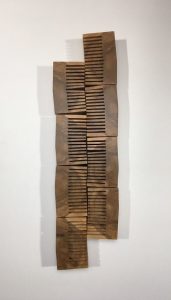
A lot of times it’s the wood that I have available. From there, either the wood will inspire what direction I want to go in, sometimes it’s the idea of exploring the aspects within the wood: I want to explore a certain form and the cuts that I’ll make to the form. It’s the material or the idea that will prompt. It depends upon what’s available.
Do you ever stumble across a piece of wood and say, “A ha! That has possibilities.”
I saw this log and said I want to do something with that. It had a lot of different branches coming off the main trunk. I thought it was really interesting. I didn’t know what I was going to do with it, but I wanted to work with it.
How much pre-planning do you do in advance of beginning a new project or composition?
Not much. Sometimes I will have an idea … But I can’t really predict what’s going to happen. A lot of the time it’s just that cutting multiple forms that are the same with slightly different variations to the cuts or the shape or the grain within the piece, and seeing how that reacts, and then reacting to what the wood does. I liken it to a conversation. I have an idea and throw it out there …
Do you work on more than one project at a time?
Sometimes I do. It depends on what’s going on as far as what I have to work with, and what else is going on in my life. It’s not something that needs to happen. The nature of the process allows for that — as far as the time it takes from starting a project, to the wood drying, to continuing to work on it after the wood has dried. There’s multiple months between those two points. I can start something, and then work on a different idea.
You’ve got things in different stages of readiness?
Yes. It’s kind of seasonal, too. I do a lot of the rough shaping of the forms in the wintertime. I find the wood dries best because of the dryer air. Toward spring and summer is when I refine those shapes and forms.
Your work is tied to the natural world in so many ways. Your materials come out of your own woods. Your processes are tied to the seasons — you do certain things because the weather has a different effect on the materials in the winter than in the summer. It’s an interesting way of working.
I do it because it makes sense. It works for me. I’ve thought of ways to dry wood in the summer when the humidity’s higher, but I haven’t needed to … It is a nice rhythm to just work with nature and the environment the way it goes.
Do you work in a series?
I definitely explore the same idea over time. I feel like its the same idea I explore over and over again with slightly different variations. I do it because I don’t know what’s going to happen …
That’s an interesting thing about your practice: You don’t try to control the materials. You are very democratic. You allow your materials to have a say.
It’s a very individualistic process. I want to know [of the wood] what are you going to do? And, what are YOU going to do?
What’s your favorite tool?
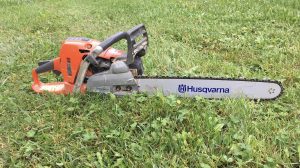
The chain saw is my favorite tool … This tool is used to take down the trees. What I like about it is similar to what happens within my piece. [The chainsaw] makes cut very quickly; but there’s a lot of interesting details that comes from that tool. That’s what I really like: the uniqueness of the results.
Do you use a sketchbook? Work journal?
I do, a little bit, not extensively. What I end up drawing is just different variations of the same thing. My work is nothing I can predict what’s going to happen to each piece, so I can draw ideas of forms I’d like to see, but that’s all they are: drawing. It’s not anything I can really control … It’s not a big planning tool for me. I use it for inspiration. Just drawing out forms I’d like to see, and how can I get this form.
How did you think about hand work before you began practicing seriously?
I was always intrigued with craftsmanship and things constructed with intent. Even in grade school, using scissors and crayons, I was pretty controlling in that work and precise — you know, coloring within the lines. When I was younger I valued controlled skill in handwork. As I’ve grown, I’ve let [the need to control] go.
Why is making things by-hand important to you?
I think it’s a great involvement for the brain to be able to make something with your hands, just to be able to successfully create something with your body is great. I encourage my children to make things. It’s what kids do: exploring, playing and exploring with their hands …. It’s a connection to your physical world.
You work with machines; but it’s at human scale so your hands don’t get overridden by the machines.
Yes. True.
I think handwork is so important because it keeps us honest about what our powers really are.
In woodworking, working with hand tools you might see more clues of that in the work.
Why does working with our hands remain valuable and vital to modern life? Or, not?
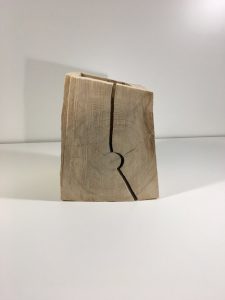
It goes back to my draw to the material I work with. We have bodies and hands and we need to be connected with what we can create with them — not just what we can create with our mind.
How do you come up with a title?
My titles are based on the thought process I go through while making the piece. Sometimes my titles are suggestive of the process — this was a struggle for me to get to this point; or there’s something that reminds me of the form I’m working on.
What’s the job of a title?
To give a clue to the viewer of what your intent was. To let the viewer know what was going through your mind when you made it.
When did you commit to working with serious intent?
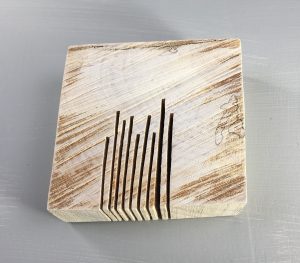
Sometimes I feel like I have to re-commit. I remember the first time when I shifted from the idea of trying to make furniture to more sculptural pieces. At the time I was doing a lot of carpentry work. I was building cupolas for a barn. It had rafters that were curved [cut from straight pieces of lumber] … After I’d cut 20-some rafters I was cleaning up the work area and I looked at this piece of [guide] wood I’d laid all the rafters on to cut [curves], and I thought to myself that I really like this piece of wood more than the cupola. [The guide wood] had all these lines [saw cuts] made by this tool in the process. That was the point I decided to really pursue sculptural forms. When I was in school, I always found myself drawing these forms that were very impractical as furniture. I struggled with that internally, [asking], “Why are you doing that? No one could every use this. Is this going to be valuable to people? Are people going to want to buy this?” But, that point, when I was cutting rafters for the cupola, I realized I wanted to make sculptural stuff. I didn’t want to make “useful” things. I wanted to explore making something to look at.
What role does social media play in your practice?
I don’t exhibit a whole lot — maybe 1 or 2 times a year — so social media is a way for me to get work out there, and get feedback during those times when I don’t have work hanging in galleries. I go through spurts of being very active on social media, and not being active at all. It’s a good way for me to get feedback from people. It’s really the main source of seeing what other people are doing.
What’s social media’s influence on the work you make?
There’s no artist that’s not influenced by [others’ work]. I see what other people are doing with wood. I see forms and lines, and I put those in my wheelhouse. It all affects me; but what kind of affect? I don’t know.
What do you believe is the visual artist’s role in the world?
To share the human experience in whatever way they individualize it … It connects people to shared emotions shared experience.
What part or parts of the world find their way into your work?
I think the history of working with the material, and what other people who’ve worked with wood have experienced before. It’s something that influences me. The historical method of woodworking before power saws was handwork. Those woodworkers found it a lot easier to work with green wood, so they capitalized on that. They worked the wood while it was green, and they knew it was going to change as it dried. So, some people started thinking about that … The thing that makes it way into my work is that basic, first knowledge of wood and how to work with it; what it’s properties are; and how to use those properties to get a result that’s something you want.
How does living in Northern Michigan inform and influence your creative practice?
There’s a lot of trees around us. If I wasn’t living here, I’d like to think I’d still be exploring the same thing. I live in a community, and my social media has some influence on me; but I draw inspiration from the landscape; but I feel I would do that anywhere. It goes back to my thoughts on observing the world, and finding beauty in small details. I don’t need to live here for my work; but for my sanity, I do. I guess that would affect my work … I choose to be here. This is my home. This is what I love. It fits me. It makes me happy, and that’s how it affects my work. It provides a supportive environment.
Did you know any practicing studio artists when you were growing up?
I guess I didn’t realize they were practicing studio artists. I had a neighbor who was an artist; but it didn’t dawn on me what that meant. He made dulcimers. He was a professor at Kent State University in the art department.
Who has had the greatest and most lasting influence on your work and practice?
I go back to the historical references. The scores of woodworkers before me who have explored the material. Those who work with wood, and push its boundaries for things other than a useful material to make functional things with.
Where or to whom do you go when you need honest feedback about your work?
I don’t do that a lot.
What is the role of the exhibiting in your practice?
It’s to share what I really enjoy and find value in with other people. It’s important to me to get my work out there.
See more of NIck Preneta’s work here.
Watch this time-lapse video of one of Nick’s pieces moving from green to dry.
Sarah Bearup-Neal develops and curates Glen Arbor Arts Center exhibitions. She maintains a studio practice focused on fiber and collage.
